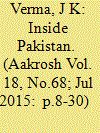| Srl | Item |
| 1 |
ID:
158095


|
|
|
|
|
| Summary/Abstract |
Following reclamation of ethnic identity amid the gnawing scarcities, Assamese ethnic movement germinated in the 1950s, manifested in the form of language and anti-migrants agitations. It became more apparent in the early 1960s. Despite the Assam accord, signed in 1985, certain section of the society with radical leanings picked up arms for a mission of secession from India. Unfortunately, State’s intervention seemingly failed to contain armed conflict, rather convoluted the situation and gave rise to hybrid ethnic identities. In this manner, since the 2000s, the entire state is engulfed in internal feuds. How have the Assamese movements shifted from the socio-cultural to armed struggle for secession and then to internal feuds, and why has the State failed in curbing them are discussed in this paper.
|
|
|
|
|
|
|
|
|
|
|
|
|
|
|
|
| 2 |
ID:
139660


|
|
|
| 3 |
ID:
130930


|
|
|
|
|
| Publication |
2014.
|
| Summary/Abstract |
We argue that system-level international changes have made secessionism more attractive since 1945, and that this is one of the reasons for the recent Proliferation of Aspiring States. Using original data on secessionist movements between 1816 and 2011, we document that secessionism became significantly more common after 1945. Whereas much of the existing literature explains secessionism by pointing to local or unit-level factors, we contend that security, economic, and normative changes at the international level have effectively increased the benefits of independence, without a commensurate increase in the costs. We use interviews with representatives of new states, secessionist groups, and international organizations to provide empirical support for these claims. We conclude by considering three extensions of our argument: (i) Does the nature of the changing international environment affect the way in which secessionists attempt to achieve their goals? (ii) What future changes might amplify or depress this trend? (iii) Who are the specific people benefiting from statehood, and can their position within a would-be state help us understand the nature of secessionism today?
|
|
|
|
|
|
|
|
|
|
|
|
|
|
|
|